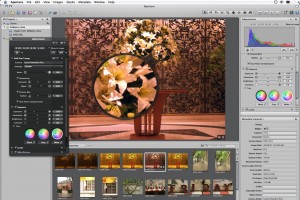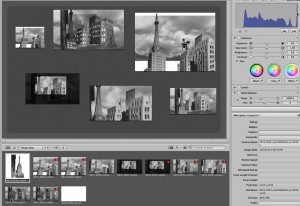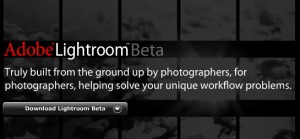Apple has just released version 1.1 of Aperture. Some would say this is not only in direct response to initial criticism to the quality of the RAW tools in version 1.0.1 but also in response to Adobe’s ‘beta’ release of Lightroom. Aperture is now available as a Universal – running up to 4 times faster and Apple have slashed the price. We compare Aperture 1.1 to Adobe Lightroom, and suggest how you can best use them in a visual effects environment.
Apple released a new version of their professional photographic software and reduced the US price to $299. Aperture was first avaliable last November for $499, and for those who purchased at the old price there is a refund of the cost difference available as an online store credit. Aperture is a tool for dealing with a lot of professional images, it is ‘iPhoto on steroids’ for Photographers – in particular processionals who shoot large RAW camera file types.
Aperture 1.1 now runs natively on both Intel- and PowerPC-based Macs. It features dramatically improved RAW image rendering and a new set of advanced RAW adjustment controls. The app also delivers impressive speed gains on any Mac and includes improved Photoshop layering interaction.
With Adobe Lightroom is currently in beta 2 for the Mac, it is impossible to discuss Aperture without discussing Lightroom. Once it was out of the shadows (Lightroom’s alpha test name was Shadowland), it had a huge impact, pre-released as it was so close after Aperture. First it was free – rather than the $499 Apple wanted. Second it was intended to be Windows and Macintosh, which clearly Aperture was not. Third it had a better RAW export. Finally it did not have the same database structure – oh and one more huge point – it was from Adobe the owners of Photoshop.
For photographers and vfx artists the success of either Aperture or Lightroom is linked to Photoshop. While it may not be the post important aspect of their eventual success or otherwise, it would be a close second, but more on that in a moment. The most important point is arguably the quality of the RAW processing. If these products are for professionals who shoot RAW then anything less than stellar RAW processing is the kiss of death. In this instance Adobe won the first round. Aperture was shown to have some technical issues with RAW processing and that became a major point for many potential buyers. This release aims to address that point.
In this week’s press release, Apple sates “Since Aperture launched just over four months ago, we’ve been incredibly focused on improving image quality and performance, working closely with pro photographers to get it right in 1.1,†said Rob Schoeben, Apple’s vice president of Applications Marketing. “With the RAW quality and overall speed of Aperture 1.1 and its new low price, there’s never been a better time for pros and hobbyists alike to take the art and craft of photography to the next level.â€

Since its release, the battle ground was always RAW file processing as any application that did not have good RAW tools could ntop be considered a true professional product. Apple has answered its critics with an new RAW engine for 1.1. Older library and older images using the Aperture RAW 1.0 tools can still be maintained but once images are updated to the 1.1 version they are not backward compatible. The RAW image rendering in Aperture 1.1 is greatly improved in areas such as noise reduction, sharpening, and highlight recovery. New RAW Fine Tuning controls allow photographers to tweak decode settings such as boost, sharpening and chroma blur. A new built-in color meter displays pixel values in RGB, Lab or CMYK in Aperture’s Loupe magnifying viewer.
The new improved RAW capabilities is a huge deal for Apple, as it is the cornerstone of their market place battle with Adobe. Some people have argued that Aperture was designed for Photographers moving to digital while Lightroom was designed for image processing artists who also take images.
Contray to rumor Lightroom was not invented in response to Aperture. The product had been in development for several years before its unveiling. Photoshop News has a blow by blow story on the development of Lightroom on their website.
But its Beta release to the public may well have been a swift reaction to Aperture by Adobe. Lightroom is not rumoured to be released until the end of the year or the beginning of next year, so Adobe’s beta release may have been a strategic move to stop Aperture getting a grip in the professional market.

While RAW processing was the initial battle ground between these two very similar programs, it may well be their respective relationships to Photoshop that ultimattely decides who wins. Photoshop is now 19 years old and with it’s current 9th version. CS2 -remains the bedrock of visual effects artists, photographers and general graphic artist the world over. But as great as Photoshop is, the program is designed to deal with one image at a time and not the sorting and mass processing of hundreds of images that a professional requires.
Photoshop was the brainchild of brothers Thomas and John Knoll (ILM) who wrote it as a tool for graphic artists and photographic retouchers. Interestingly, it was also Thomas Knoll who later developed the CAMERA RAW plugin and capabilities of Photoshop, which are now central to both Lightroom and Aperture.
Given the dominant position of Photoshop in retouch and image processing, it was surprising how poorly Aperture 1.0.1 dealt with PSD files. With version 1.1 Apple has now improved Photoshop handling – but only to a point.
Here is what you need to know about working with Photoshop files in Aperture:
* If you now adopt Photoshop as your default image editing app in Aperture’s preferences, it will now output your images as 16 bit if your dealing with TIFFs (Aperture 1.0.1 only did 8 bit Tiffs).

*You can bring PSD files into Aperture and they will not automatically be flattened. This is the improved layering interaction Apple has flagged in their marketing. However if you colour adjust the images – or apply anything to them in Aperture they will be flattened.So if you have a image with 6 layers – you load it into Aperture and then hit Shift Command O – the PSD file will open in Photoshop without fault, if you have adjust the black hue, it will open as a 1 layer flattened image. This is because a PSD file stores a flattened version of any comp along with the layers in the normal PSD file format. Once lost these layers are gone, you can’t just jump between Aperture and Photoshop making changes and revising unless you your comfortable working with a 1 layer image. You lose some of the benefit of the non-destructive editing every time you make the leap.
* PSD files can be viewed, arranged and sorted in Aperture without flattening.
* There is no save button in Aperture. It is designed around a SQL database. In other words, it only knows about and can process a PSD file inside Aperture. Much in the same way iPhoto can have only one library at a time open, Apperture can only have a library as big as its current hard drive and you can’t split your work up over multiple drives. Like iPhoto, you can have multiple libraries but you can’t open them together or easily move, browse or exchange PSD or any images easily between libraries.

Lightroom, on the other hand, uses a more traditional modern file structure. This means Lightroom accesses your files/photos that are located anywhere, on any drive. Lighroom may well have another huge advantage, Adobe is loudly saying that they are going to make an SDK available. This is important, because it provides a way for Lightroom to grow and be built into large enterprise pipelines. Users should be able to develop archiving and project management tools through custom SDK scripts. At the time of writing there is a little information on how solid, wide open or easy the Adobe SDK will be to use.
Of course everyone expects Adobe to allow very tight integration between Lightroom and Photoshop.
Where Lightroom is weak is in clear user interface design and layout. Aperture makes it easy to arrange, stack and review hundred of images. This is increasingly a huge problem as Digital Photography allows hundreds of times more images to be snapped than old style film with this limited loads and expensive processing.
Apple has successfully answered the problems with Aperture’s initial release. It must now build on this new solid base to more widely integrate Aperture into the workflows of people who not only take the images but also manipulate them. Apple also has a cleaner workflow. By some accounts Lightroom was delayed while resoruces were devoted to CS2’s new Bridge program – which partly does the same job as the other two programs but far less elegantly.
Adobe has also created a potential problem providing Lightroom for free while it is in beta testing. Charging much for it may be difficult and no matter what sensible warning people are given, as the beta times out and people are forced to buy Lightroom, it could cause some backlash.
Adobe has about six months to try and capture some of Apple’s great ease of use and layout design. In a sense Adobe has had it easy so far. The product is not actually ‘released’ and one can’t be too harsh on its unimplemented feature list. This will need to change and exactly how it can make Lightroom not awkwardly bump into Adobe Bridge will be an interesting task. While Apple’s Aperature 1.1 has shown the huge speed improvements of releasing a Universal binary version for the Intel Macs, Adobe has yet to do so. This is a task that must be a greater priorty than releasing Lightroom.
With the reduced price of Aperture one can only expect that a wider audience will now be interested in the product, but still many people will undoubtly hang off to see the final release and final price of Lightroom.
